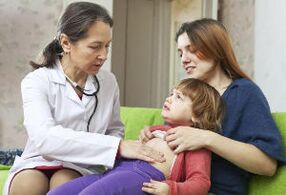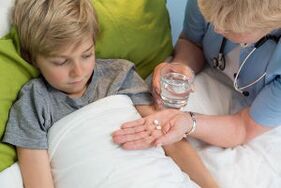Parasitic diseases are another type of disease caused by protozoa or worms (helminths). According to statistics, helminthiasis and giardiasis occur in 78-80% of preschool children and elementary school students. Parasitic worms and arthropods poison the human body through the products of their life activities, and observe the damage of life systems and organs accordingly.
Giardia and Worms-Similarities and Differences

Many people mistakenly believe that Giardia is a worm that parasitizes the gastrointestinal tract. These microorganisms and other microorganisms are parasites and enter the human body in the same way. However, worms and Giardia are representatives of different categories, and the damage they cause to children's health is different in structure and degree:
- Giardia is a protozoan with flagellum that parasitizes the mucous membrane of the small intestine. Single-celled microorganisms can exist in two forms:
- Pores-the transformation of Giardia into cysts when adverse conditions occur. It retains its activity in the external environment in this form, and when it penetrates into living organisms, it begins to develop;
- Nutrition-Giardia's active development in the intestines absorbs all the nutrients needed for growth and reproduction.
- Worms are parasites that can infect almost all types of tissues. There are more than 400 types of worms, but they all belong to one of the following types:
- Insects-Echinococcus occidentalis, wide slate, pork tape insects;
- Flukes-flukes;
- Worms-Toxoplasma gondii, pinworm, whipworm.
Drinking water or food contaminated with cysts and eggs can infect children with parasites. The carriers of worm eggs and amniotic cysts are cats and dogs. Mosquitoes, flies and other insects that carry round eggs, hydatid oc, etc. on the long-snout carry promote the development of parasitic diseases.
Clinical manifestations of Giardiasis (Giardiasis)
Parasitic infections are more common in children between 1 and 4 years of age. In about 30% of cases, the parasitic disease is asymptomatic and is discovered during the diagnosis of another disease by laboratory tests. Typical symptoms of giardiasis in children include:
- Decreased appetite;
- Flatulence
- dizziness;
- Poor sleep
- lose weight;
- Violation of stool;
- irritability;
- Belly button pain;
- Upper abdominal discomfort
- Enlarged liver;
- Biliary dyskinesia;
- Allergic dermatitis.
In young children, giardiasis is more serious than in adults. The waste poisoning of Giardia can cause skin color changes, pimples and dark circles under the eyes. A blood test showed an increase in the concentration of eosinophils in the plasma. In feces, parasites are not always detectable, which is related to the particularity of its developmental cycle.
Clinical manifestations of helminthiasis

Symptoms of helminthiasis appear 2-4 weeks after the parasite enters the child's body. In about one-third of patients, the symptoms of parasitic diseases are weak, but the toxic effects of their waste have not stopped. The main manifestations of helminthiasis in children include:
- Fever status;
- Exudative rash;
- Swelling of the face;
- Sparse stool;
- Swollen lymph nodes;
- Flatulence
- Stomach cramps;
- tension
- insomnia;
- Chronic fatigue.
Note: Immune deficiencies, vitamin deficiencies and mineral deficiencies promote the development of complications associated with helminthiasis.
A large number of invasions can damage vital organs, as evidenced by the development of myocarditis, pleuropneumonia, and meningoencephalitis. The degree of eosinophilia in helminthiasis depends on the patient's immune status and the intensity of the infection.
Treatment of Giardiasis
The treatment of giardiasis does not start with the use of antiparasitic drugs, because this may lead to serious toxic allergic complications. In this regard, treatment is carried out in three stages:
- Following the diet plan for 14 days can help eliminate poisoning. In order to improve the enzymatic activity of the intestines and increase the overall immunity, it is necessary to add grains, grains, dried fruits and vegetable oils to the diet. In order to reduce the concentration of toxins in the blood, children are prescribed intestinal absorbers, bile and antihistamines.
- Intensive antiparasitic therapy helps eliminate active lambs and cysts. For the destruction of protozoa, usually use: "Nifuratel", "Metronidazole", "Ornidazole";
- In order to improve bowel movements, it is recommended to add fermented milk products, cereals and baked apples to the menu. You can use prebiotics, multi-vitamins and herbs to adapt to the original to strengthen your child's immune system.
In the acute course of giardiasis, a one-stage treatment plan with antiparasitic drugs was prescribed. Among them, the most effective ones are: "Albendazole", "Tinidazole", "Mepacrine", "Furazolidone" and so on.
Treatment of helminthiasis

The principle of deworming is determined by the type of parasite that causes the disease to develop. The main goal of treatment and preventive measures is to reduce the invasion of worms in the intestines and enhance non-specific immunity. The following types of drugs can be used to eliminate worms:
- Anti-nematode-"Mendazole", "thiazole";
- antestestoid-"praziquantel", "niclosamide";
- protivotrematodoznye.
Many of the above drugs may cause side effects such as anemia and intestinal bleeding. In order to prevent health deterioration during treatment, it is recommended to use "filgrastim", "dioxomethyltetrahydropyrimidine", "ursodeoxycholic acid", and "Colspitol".
in conclusion
Giardia and worms are representatives of different types of parasitic microorganisms that enter the human body in the same way. The clinical manifestations of helminthiasis and giardiasis are very different, which is related to the different principles of their development and infiltration sites. Antiparasitic treatments for diseases include various drugs designed to eliminate certain types of pathogens.










